Semantic SEO: Leveraging Meaningful Content for Better Rankings
Semantic SEO: Leveraging Meaningful Content for Better Rankings
In the landscape of digital marketing, Semantic SEO refers to the strategic optimization of web content to align with the nuanced understanding of search engine algorithms regarding user intent and context. This approach is pivotal in modern search engine algorithms as they prioritize relevance and user experience. By integrating Semantic SEO, businesses enhance their visibility and credibility online, reaching their target audience effectively. Leveraging meaningful content facilitates higher rankings by ensuring that websites provide valuable, contextually rich information, thus satisfying user queries comprehensively.
Understanding Semantic SEO
Semantic SEO marks a shift from keyword-centric to context-driven strategies. It involves analyzing user intent and the semantics of search queries. Key components include semantic markup, natural language processing, entity optimization, and contextual relevance. Semantic SEO offers benefits such as improved ranking accuracy and enhanced user experience. Embracing this approach ensures content aligns with user expectations and search engine algorithms. For effective Semantic SEO, you require an SEO agency that specializes in providing comprehensive SEO services and is proficient in Semantic SEO. Our experience with the The Frank Agency has been excellent; they are experts in this field.
Evolution from keyword-based to semantic-based search
In the realm of SEO, the transition from keyword-centric strategies to Semantic SEO signifies a profound shift in search engine algorithms. Gone are the days of keyword stuffing; now, search engines prioritize understanding user intent and context.
Key Components of Semantic SEO
Semantic markup and structured data play a pivotal role in conveying the meaning behind content to search engines, aiding in better comprehension and indexing.
Natural language processing (NLP) empowers search engines to decipher the nuances of human language, enabling more accurate interpretations of search queries.
Entity optimization focuses on establishing the identity and relevance of entities mentioned within the content, enriching the depth of information provided to users.
Contextual relevance emphasizes aligning content with the broader context of a user’s query, enhancing the overall user experience and satisfaction.
Benefits of Semantic SEO over traditional SEO approaches
Embracing Semantic SEO yields manifold benefits, surpassing the limitations of traditional SEO methodologies. By prioritizing relevance and user intent, Semantic SEO elevates ranking potentials, fosters enhanced visibility, and cultivates a more meaningful connection between content and audience.
Creating Meaningful Content

Creating meaningful content involves meticulously understanding your target audience’s search intent and preferences. By optimizing your content for semantic relevance through strategies like incorporating long-tail keywords, crafting comprehensive articles, and utilizing synonyms, you can enhance your SEO efforts and improve ranking outcomes. Remember, in the realm of Semantic SEO, high-quality and engaging content is essential not only for algorithmic favor but also for fostering meaningful connections with your audience.
A. Identifying the target audience and their search intent
Understanding the intricacies of your audience’s search intent is paramount in the realm of SEO. By delving deep into user personas and behavior patterns, you can unravel the nuances of their queries and preferences.
B. Content optimization strategies for semantic relevance
Incorporating long-tail keywords enables you to capture more specific search queries, enhancing the chances of ranking for niche topics.
Crafting comprehensive content that addresses user queries not only satisfies search intent but also establishes authority and trustworthiness.
Ensuring content depth and breadth involves covering a wide array of relevant topics comprehensively, catering to various facets of user interest.
Utilizing synonyms and related terms enriches the semantic context of your content, enhancing its relevance and visibility in search results.
C. Importance of high-quality, engaging content in Semantic SEO
In the landscape of Semantic SEO, high-quality, engaging content serves as the cornerstone of success. Beyond merely adhering to algorithmic requirements, captivating content fosters user engagement, driving ranking improvements and establishing enduring connections with your audience.
Leveraging Semantic Markup and Structured Data

Incorporating semantic markup and structured data into your website not only aids search engines in comprehending the content but also enhances the user experience by providing more informative and visually appealing search results. By adequately implementing schema markup, websites can earn rich snippets, knowledge panels, and other enhanced features in search engine results pages, significantly boosting ranking and click-through rates. Additionally, structured data facilitates better indexing and categorization of web content, contributing to overall SEO effectiveness and visibility.
A. Overview of schema markup and its role in Semantic SEO
Schema markup is a form of microdata that provides search engines with additional context about the content on a webpage. In the realm of SEO, it plays a crucial role in enhancing the Semantic understanding of web content, ultimately improving ranking outcomes.
B. Implementing structured data for better search engine understanding.
Various types of schema markup cater to different content types, including articles, events, and products, enabling search engines to better interpret and display this information in search results.
Best practices for schema implementation include ensuring accuracy, relevancy, and compliance with schema.org guidelines to maximize the effectiveness of structured data.
Tools and resources for adding structured data to web pages, such as Google’s Structured Data Markup Helper and Schema.org’s markup generator, streamline the process and facilitate proper implementation.
Leveraging semantic markup and structured data empowers websites to provide more prosperous, contextually relevant information to search engines, improving SEO ranking and enhancing web content visibility.
Optimizing for Entity Recognition

Optimizing for entity recognition involves a nuanced understanding of how search engines interpret and categorize entities within content. Businesses can bolster their authority and relevance in search algorithms by strategically crafting content around specific entities and fostering connections with reputable sources. Leveraging social media platforms and monitoring engagement metrics further solidifies entity credibility, ultimately contributing to improved SEO ranking and enhanced visibility online.
A. Understanding entities and their significance in Semantic SEO
Entities represent people, places, things, or distinct and identifiable concepts. In SEO, entities play a pivotal role in enhancing Semantic understanding and improving ranking outcomes by providing search engines with structured data about the content.
B. Strategies for optimizing content for entity recognition
Creating authoritative content centered around specific entities establishes credibility and reinforces their relevance to search engines.
Linking to reputable sources strengthens the association between entities and enhances the overall trustworthiness of the content.
Leveraging social media and other platforms to showcase expertise can further solidify entity credibility in the digital sphere.
Monitoring entity mentions, and engagement metrics allows for ongoing optimization and refinement of content strategies to better align with Semantic SEO objectives.
Optimize for entity recognition involves a multifaceted approach that emphasizes the creation of authoritative, contextually rich content while actively reinforcing entity associations through strategic linkages and engagement efforts. Businesses can effectively enhance SEO ranking and establish a more robust digital presence by prioritizing entities in content optimization strategies.
Incorporating Natural Language Processing (NLP)

Incorporating Natural Language Processing (NLP) techniques into content creation empowers businesses to align with the evolving landscape of search engine algorithms. Writing in natural language with proper grammar and syntax makes content more accessible to NLP algorithms, facilitating better understanding and indexing. Additionally, addressing user queries directly within content and leveraging sentiment analysis enhances Semantic relevance and fosters deeper engagement and connection with the audience. Through strategic integration of NLP, businesses can optimize content for improved SEO ranking and enhanced user experience.
A. Introduction to NLP and its Role in Semantic SEO
Natural Language Processing (NLP) revolutionizes how search engines comprehend and analyze human language. In SEO, NLP is pivotal in enhancing Semantic understanding and optimizing content for better ranking outcomes.
B. Techniques for optimizing content for NLP algorithms
Writing in natural language with proper grammar and syntax ensures that NLP algorithms easily digest content, facilitating more accurate interpretation and indexing.
Answering user queries directly within content aligns with the conversational nature of NLP-powered searches, enhancing relevance and user satisfaction.
Utilizing sentiment analysis enables businesses to gauge user preferences and tailor content accordingly, fostering deeper engagement and connection.
Adapting content for voice search and conversational interfaces anticipates the increasing prevalence of voice-based interactions, ensuring compatibility and visibility in evolving search landscapes.
Incorporating NLP techniques into content strategies enhances Semantic SEO efforts and future-proofs content for the changing nature of search technologies. By embracing NLP, businesses can optimize content for better ranking outcomes and foster meaningful interactions with their audience.
Measuring Success and Iterating
Measuring success in Semantic SEO involves tracking key performance indicators such as click-through rates and conversion rates to assess the impact of optimization efforts. Analyzing search engine ranking positions and organic traffic provides valuable insights into the visibility and reach of optimized content. By gathering insights from user engagement metrics, businesses can iteratively refine their Semantic strategies to better align with user preferences and enhance overall SEO performance.
A. Key performance indicators (KPIs) for Semantic SEO
In the realm of SEO, monitoring key performance indicators (KPIs) is essential to gauge the effectiveness of Semantic strategies. These may include metrics such as click-through rates, conversion rates, and dwell time, reflecting the impact of Semantic optimization on user engagement and satisfaction.
B. Analyzing search engine rankings and organic traffic
Regularly tracking ranking positions and organic traffic provides valuable insights into the visibility and reach of optimized content. Fluctuations in ranking can indicate the efficacy of Semantic strategies, while changes in organic traffic reflect the impact on overall website performance.
C. Gathering insights from user engagement metrics
Such as bounce rate and time on page, offers valuable insights into content relevance and resonance with the audience. Analyzing these metrics enables the refinement of Semantic approaches to better align with user preferences and behavior.
D. Iterative optimization based on data-driven analysis
Involves continuously refining Semantic strategies based on data-driven analysis of KPIs and user engagement metrics. This iterative approach allows for ongoing improvement in SEO performance and ensures alignment with evolving search engine algorithms.
Measuring success in Semantic SEO necessitates a comprehensive approach, encompassing analysis of KPIs, ranking positions, organic traffic, and user engagement metrics. By iteratively optimizing based on data-driven insights, businesses can continually enhance their SEO efforts and drive sustainable growth online.
Conclusion:
Semantic SEO is a cornerstone for enhancing online visibility and user engagement. By understanding its significance, businesses can optimize content for search engines effectively. Leveraging meaningful content boosts rankings and fosters genuine connections with audiences. The future of Semantic SEO promises innovations like natural language processing and AI-driven algorithms, shaping a landscape where context and relevance reign supreme. Embracing these advancements will be pivotal for staying ahead in the ever-evolving digital sphere.
About Author:
Zain Bin Zameer

 in Melbourne
in Melbourne 
 Employee Screen Monitoring Software
Employee Screen Monitoring Software App and Website Monitoring Software
App and Website Monitoring Software Time and Attendance Software
Time and Attendance Software Finance
Finance Banking
Banking Healthcare
Healthcare Lawyers
Lawyers Retail & ecommerce
Retail & ecommerce Knowledge base
Knowledge base Blogs
Blogs Installation Guide
Installation Guide FAQs
FAQs About
About Media Kit
Media Kit Contact us
Contact us